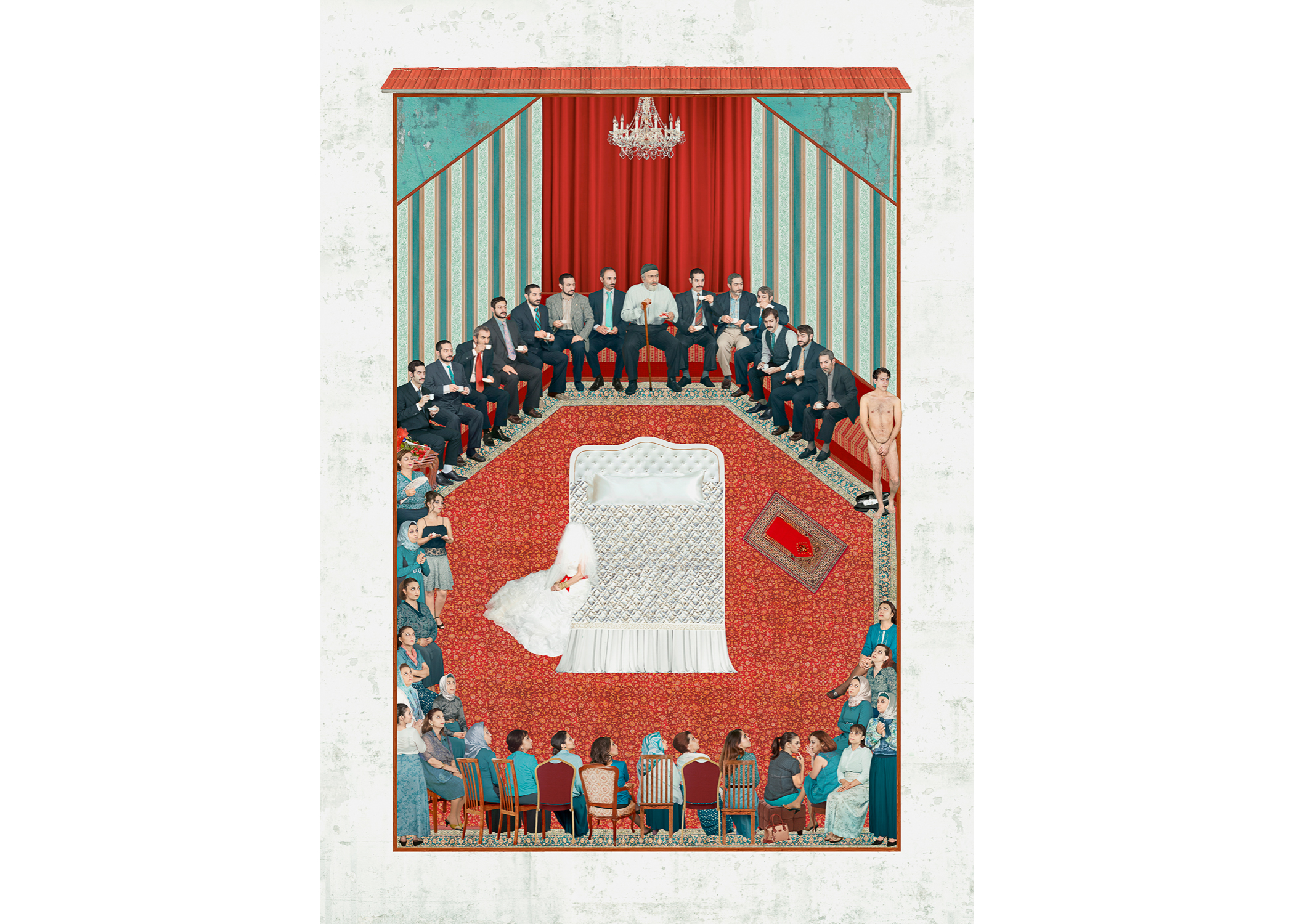Sinan Tuncay at United Photo Industries Gallery
Image above: ©SinanTuncay, Bridal Bath, Public Intimacy, 2015 / Courtesy of United Photo Industries
Sinan Tuncay’s first solo exhibition, I’m Sorry, Leyla, is a study of paradoxes, rooted firmly in his life experience. It is also an examination of Turkey, his home country, where the proverbial East meets West. As a lens-based artist, Tuncay works with both still and moving images to explore gender “as it is fetishized around female virginity and the heteronormative image of masculinity.” His work progresses through four parts, exploring a boxed-in, restrained femininity in re-creations of 1960’s Turkish soap operas (Mommy’s Not Home), traditional Turkish wedding practices that simultaneously restrain and fetishize sexuality and virginity (Public Intimacy), homoeroticism as it is revealed through male interactions with peers and self (Fraternal), and the final attempt to cast-off and simultaneously imitate social norms (Self-portrait as Leyla), where the artist transforms himself into The Perfect Woman, one he can never be with in the way society would have him do, and yet can also never be.
Image above: ©SinanTuncay, Wedding Night, Public Intimacy, 2015 / Courtesy of United Photo Industries
Tuncay’s work abounds in the contradictions of life, representing in numerous iterations the conflict created within a nation—and within an individual—when seemingly disparate realities coexist: religious and secular, East and West, sexual and spiritual, masculine and homoerotic, traditional and subversive, liberated and contained, Turkish and gay. Despite people who would have it be otherwise, the contradictions stubbornly remain, and though they are often at odds with each other, they continue to exist simultaneously.
Image above: ©Elizabeth Mealey, Opening Night, Sinan Tuncay (in white)
Tuncay says he never really belonged in or felt accepted by mainstream Turkish culture, where religious conservatism and heteronormativity are prominent, yet his work is deeply rooted in his Turkish identity. And though his engagement with his country and culture is critical, it is not unloving. His work often presents a critique of the traditional, for instance in Wedding Night where a bride and groom’s first sexual encounter is scrutinized in public. And yet he also embraces Turkish tradition through the style of his images, which consciously reference Ottoman pictorial art. Though he is critical of the “desired interior passiveness of femininity” performed in 1960’s soap operas, the artist nevertheless expresses an unashamed passion for melodrama: denouncing and embracing, critical and loving. Simultaneously.
Image above: ©Elizabeth Mealey, Opening Night
Walking through the exhibit, a distinct color palette becomes apparent as a unifying thread, with red and turquoise featured prominently in each work. This is intentional, the artist explains: the colors are symbolic, and reference the main contradicting themes. Turquoise is a color literally named after the Turkish people, and so, in Tuncay’s work, turquoise is associated with all that is Turkish, and especially that which is traditional or old. Red, on the other hand, represents sex, and all that is sensual and modern and often repressed. But again, while the artist sees these colors as representing opposites, he allows them to commingle; both colors are present within every frame of his work. While a picture of men praying in a mosque is dominantly turquoise, their prayer rugs are red; and while an image of feasting and revelry is presented on a backdrop of red, most of the revelers are dressed in turquoise-blue. His use of color also suggests something else—that opposites don’t just exist side-by-side, but can truly be present within one thing. A sexual prayer-rug? A traditional homoerotic encounter? Perhaps, this work suggests, these things can—and do—exist.
Image above: ©Elizabeth Mealey, Opening Night
Through his study of paradox, the artist ultimately calls into question, and inverts, everything that is considered normal in conventions of gender and sexuality. The crowning work, Self-portrait as Leyla, is representative of this. When he realizes he cannot be with Leyla, The Ideal Woman, the artist becomes her instead. But when asked, “What happens when you become Leyla?” He says, “It’s not real. I’m not really her. It’s an illusion.” Just as the performance of femininity in 1960’s melodramas is an illusion. Just as any ideal of a Perfect Man, Perfect Woman, Perfect Masculinity or Perfect Femininity is an illusion. By representing and ultimately embodying paradox, Tuncay pushes past stereotypes into a more complex, conflicted, and honest reality.
Image above: ©Elizabeth Mealey, Opening Night
Text by Elizabeth Mealey
Sinan Tuncay's first solo show, "I'm sorry, Leyla," is on view through May 26, 2016, at the United Photo Industries Gallery on 16 Main Street, DUMBO, Brooklyn.










